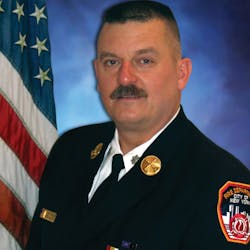The Fire Scene: What Are You Looking For?
Everyone knows that performing a 360-degree survey of a structural fire is valuable. Not every type and size of building lends itself to this, but when possible, it should be performed.
What should you look for? Obviously, you should look for fire. (If you see flames venting from the rear kitchen window, you might have a kitchen fire.) What else? Let’s take a look at a 360 survey for a reported fire in a one-story private dwelling.
Start at the D side
You are the officer of the first-arriving engine. The ladder is pulling in behind you. There’s your first piece of information: You aren’t alone. Another crew is on scene and will be initiating ladder company tactics.
So, you begin your walk around going counterclockwise. As you turn left onto the D side, you see light smoke coming from around the edges of all of the windows. Nothing dramatic, just smoke “leaking” from around the window. No smoke from the attic vent on the gable end. The house appears to be a wood-frame structure.
On the C side, you see heavier smoke from several windows and flames just breaking through the glass on the kitchen window. Next to that, an entrance door has smoke showing, too. The smoke that’s coming from the next few windows gets lighter. On the B side, very little smoke is showing, and none from the attic vent.
As you finish your survey, you realize that the house is quite small, and the B and D sides are only 15 or 20 feet deep. At the front of the house, another engine arrived; the officer asks what you need from them.
A wealth of information
Now that the 360 is completed, you collected numerous important details:
The fire looks as though it’s a kitchen fire, which means that it’s a fire that’s in a nonconfined area that can and will spread quickly to adjoining areas and rooms
Because you found visible flames in and around the kitchen window, it’s likely that the fire flashed over
It looks like a short distance from the front door to the fire area, so a single length of hose might do the job from the front door
The truck probably already gained entry and began its search, so you can call on the radio to collect more information
Because the second engine is on scene, your backup, or second, line is immediately available if needed; that engine also may perform RIT duties if needed
With the lack of any smoke coming from any of the vents that are at either end of the house, it looks as though the fire hasn’t extended to the attic area
You know that your assignment is two engines and one truck; however, based on the conditions that you observed, you can call for more units if necessary
If you encounter difficulty or even an emergency situation while attacking the fire, the rear door at the kitchen is an alternate escape point; furthermore, if any condition prevents the first line from entering the front door, the rear door could be used to get water on the fire
Improving the outcome
There might be several more pieces of information that can be uncovered or other conclusions that can be drawn during this or any other 360 survey. The important point here is that this simple, relatively quick, initial tactic can have a dramatic positive effect on just about any structural fire operation. This basically is a “less than one minute walk around” that can provide the first-arriving officer and the crew with vital clues that will help them more rapidly locate victims and extinguish the fire. It also makes the fire attack a safer and more effective operation for the firefighters.
Don’t forget your 360!
About the Author
John J. Salka Jr.
Battalion Chief
JOHN J. SALKA JR., who is a Firehouse contributing editor, retired as a battalion chief with FDNY, serving as commander of the 18th battalion in the Bronx. Salka has instructed at several FDNY training programs, including the department’s Probationary Firefighters School, Captains Management Program and Battalion Chiefs Command Course. He conducts training programs at national and local conferences and has been recognized for his firefighter survival course, “Get Out Alive.” Salka co-authored the FDNY Engine Company Operations manual and wrote the book "First In, Last Out–Leadership Lessons From the New York Fire Department." He also operates Fire Command Training, which is a New York-based fire service training and consulting firm.

